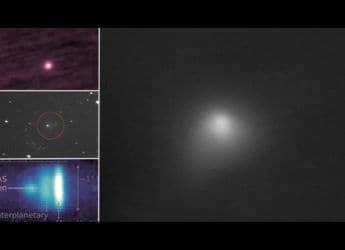- Home
- Science
- Science News
- Solar Storm From Four Sun Eruptions Could Cause Minor Geomagnetic Activity
Solar Storm From Four Sun Eruptions Could Cause Minor Geomagnetic Activity
Four coronal mass ejections from the Sun are expected to reach Earth between October 15–17.

Photo Credit: NOAA
Four CMEs from the Sun may trigger G1 geomagnetic storms and vivid auroras across mid-high latitudes
There are 4 coronal mass ejections (CMEs) that are approaching Earth and will have the potential to cause spectacular auroras on Earth this week. Although the eruptions will not cause significant disturbances, they might lead to slight geomagnetic storms and colourful northern lights that can be seen in the high latitude areas and, perhaps even, in the lower parts of the latitudes. These parallel bursts of the sun are closely observed by scientists and researchers as they head to Earth.
What's Happening on the Sun — and What It Means for Earth
According to the NOAA's Space Weather Prediction Center, between October 11 and 13, the Sun released a series of CMEs in an active sunspot region (AR4246), and eruptions were forecasted to reach between October 15 and 17. Various disturbances will be the strongest at the end of October 15 to October 16, and they may cause a G1 (minor) geomagnetic storm.
The lowest category of storm on a five-point scale of NOAA is G1, which can generate significant auroras in far north and favourable mid-latitude sources. The moderate storms may bring about small-time disruptions in power systems, hits on satellites and radio interference
How and Where to Watch — Tips for Skywatchers
The visibility of the moon is time and place-specific and is subject to clear skies. The greatest opportunities are experienced after sunset and preceding the middle of the night in dark country with a clear northern horizon. The Aurora 30-Minute Forecast is a monitoring tool provided by NOAA that allows the observation of real-time activity.
Although the conditions may appear silent, solar storms tend to vary. Several nights spent on the alert might give the spectators a stunning natural light display across the skies.
Get your daily dose of tech news, reviews, and insights, in under 80 characters on Gadgets 360 Turbo. Connect with fellow tech lovers on our Forum. Follow us on X, Facebook, WhatsApp, Threads and Google News for instant updates. Catch all the action on our YouTube channel.
Related Stories
- Samsung Galaxy Unpacked 2025
- ChatGPT
- Redmi Note 14 Pro+
- iPhone 16
- Apple Vision Pro
- Oneplus 12
- OnePlus Nord CE 3 Lite 5G
- iPhone 13
- Xiaomi 14 Pro
- Oppo Find N3
- Tecno Spark Go (2023)
- Realme V30
- Best Phones Under 25000
- Samsung Galaxy S24 Series
- Cryptocurrency
- iQoo 12
- Samsung Galaxy S24 Ultra
- Giottus
- Samsung Galaxy Z Flip 5
- Apple 'Scary Fast'
- Housefull 5
- GoPro Hero 12 Black Review
- Invincible Season 2
- JioGlass
- HD Ready TV
- Laptop Under 50000
- Smartwatch Under 10000
- Latest Mobile Phones
- Compare Phones
- Poco F8 Ultra
- Poco F8 Pro
- Huawei Mate 80 RS Master Edition
- Huawei Mate 80 Pro Max
- Huawei Mate 80 Pro
- Huawei Mate 80
- Huawei Mate X7
- Honor 500
- Asus ProArt P16
- MacBook Pro 14-inch (M5, 2025)
- Poco Pad M1
- Poco Pad X1
- Honor Watch X5
- Huawei Watch Ultimate 2
- Acerpure Nitro Z Series 100-inch QLED TV
- Samsung 43 Inch LED Ultra HD (4K) Smart TV (UA43UE81AFULXL)
- Asus ROG Ally
- Nintendo Switch Lite
- Haier 1.6 Ton 5 Star Inverter Split AC (HSU19G-MZAID5BN-INV)
- Haier 1.6 Ton 5 Star Inverter Split AC (HSU19G-MZAIM5BN-INV)

















